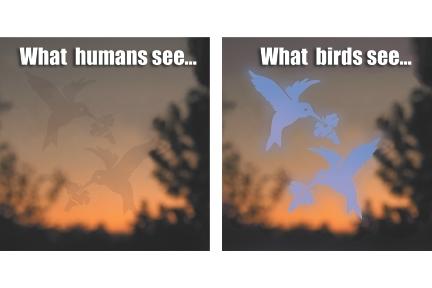Worried about your backyard birds hitting your windows?
Some helpful information to consider as you setup your backyard bird feeding stations!

Several 100 million birds are killed each year because of window collisions.
Several 100 million birds are killed each year because of window strikes. Researchers have determined, since birds cannot perceive most glass as a barrier, instead they see it as continuation of their habitat and something they should be able to fly through. Therefore, they can hit windows of any size and at any height (from a one-story house to high-rise building), day or night.
Almost half of all window collisions occur at residential homes (44%) and over half at low-rise buildings (56%). Fewer than 1% occur at high-rise buildings. This is because there are about 123 million residential homes across the nation, 15 million low-rise buildings, compared to 22,000 high-rises. This is why window collisions need to be addressed at all scales of development to save our world’s birding population.
During the day strikes most often occur because the glass windows reflect the sky or nearby greenery. However, most birds migrate during the night using the stars to navigate and are mistakenly drawn to the city lights particularly in urban areas along the migratory flyways.
In general, birds, regardless of their shape or size, travel at a high enough speed that a window collision is almost always fatal. Birds which survive the initial impact of the window strike are stunned and usually fall prey to predators such as domestic cats before they can take off.
Birds of all shapes and sizes travel at speeds high enough that a window collision almost always proves fatal. Birds that survive immediate impact are stunned and often fall prey to predators, like domestic cats, soon after a collision.
What we can do to prevent or decrease window strikes in our area?

The most common solution is:
1) use a window decal or window film to cover the area. This way the birds can see the decal and it should prevent them from flying into the window. The following are other options if window strikes are common on your property.
2) Reorganizing your backyard – if birds keep striking your window, then it may be necessary to move feeder & baths far away from your windows (>30 feet) or close to (<3 feet). Move large houseplants away from windows. If these are concerns for you, can you always get your Backyard Habitat Certified.
3) Cords, Netting, & Screens – when applied correctly these products can cover the windows to help reduce collisions. Applying sunshades to your windows will help reduce the reflections and in theory reduce collisions.
4) Lighting Solutions – more and more cities are doing Lights Out pledges in their communities. These are usually during migration seasons: mid-March through early June and late August through mid-November. At other times of the year, they should make sure all exterior lighting is properly shielded and aimed downwards. Exterior lighting should be converted to warm light LED, under 3,000 Kelvins. Make sure not to over-light areas and switch to motion sensor lighting.

